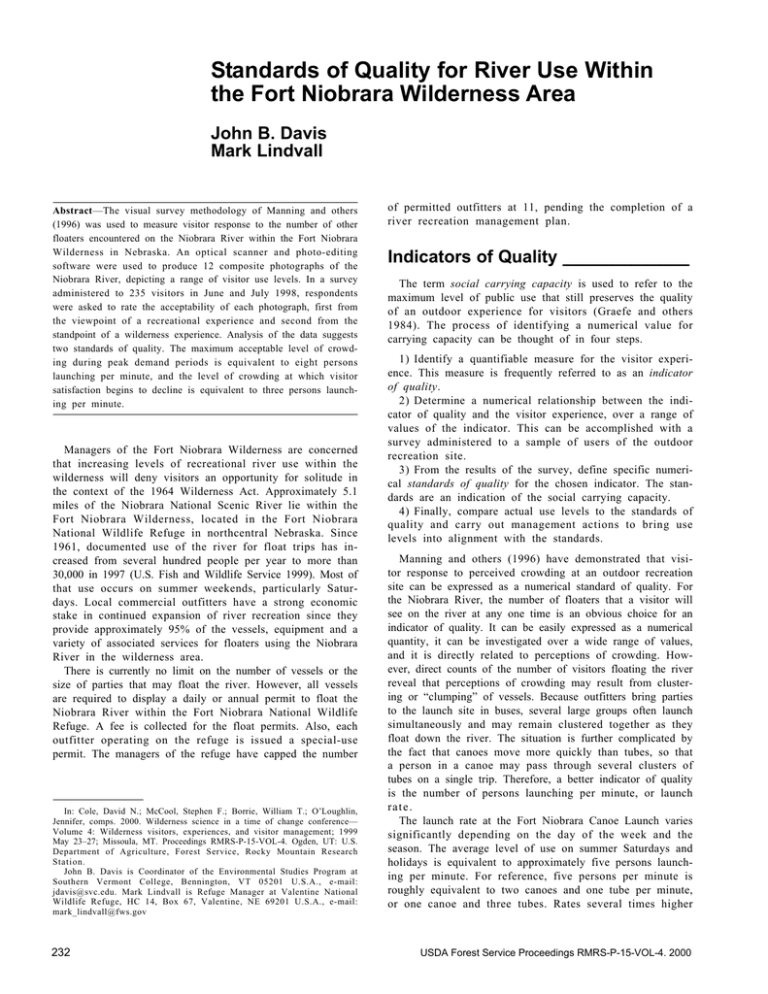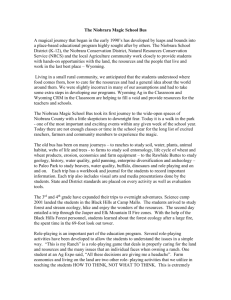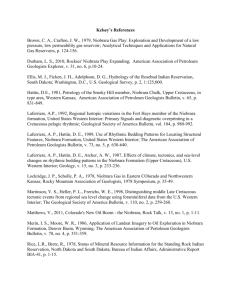Standards of Quality for River Use Within John B. Davis Mark Lindvall
advertisement

Standards of Quality for River Use Within the Fort Niobrara Wilderness Area John B. Davis Mark Lindvall Abstract—The visual survey methodology of Manning and others (1996) was used to measure visitor response to the number of other floaters encountered on the Niobrara River within the Fort Niobrara Wilderness in Nebraska. An optical scanner and photo-editing software were used to produce 12 composite photographs of the Niobrara River, depicting a range of visitor use levels. In a survey administered to 235 visitors in June and July 1998, respondents were asked to rate the acceptability of each photograph, first from the viewpoint of a recreational experience and second from the standpoint of a wilderness experience. Analysis of the data suggests two standards of quality. The maximum acceptable level of crowding during peak demand periods is equivalent to eight persons launching per minute, and the level of crowding at which visitor satisfaction begins to decline is equivalent to three persons launching per minute. Managers of the Fort Niobrara Wilderness are concerned that increasing levels of recreational river use within the wilderness will deny visitors an opportunity for solitude in the context of the 1964 Wilderness Act. Approximately 5.1 miles of the Niobrara National Scenic River lie within the Fort Niobrara Wilderness, located in the Fort Niobrara National Wildlife Refuge in northcentral Nebraska. Since 1961, documented use of the river for float trips has increased from several hundred people per year to more than 30,000 in 1997 (U.S. Fish and Wildlife Service 1999). Most of that use occurs on summer weekends, particularly Saturdays. Local commercial outfitters have a strong economic stake in continued expansion of river recreation since they provide approximately 95% of the vessels, equipment and a variety of associated services for floaters using the Niobrara River in the wilderness area. There is currently no limit on the number of vessels or the size of parties that may float the river. However, all vessels are required to display a daily or annual permit to float the Niobrara River within the Fort Niobrara National Wildlife Refuge. A fee is collected for the float permits. Also, each outfitter operating on the refuge is issued a special-use permit. The managers of the refuge have capped the number In: Cole, David N.; McCool, Stephen F.; Borrie, William T.; O’Loughlin, Jennifer, comps. 2000. Wilderness science in a time of change conference— Volume 4: Wilderness visitors, experiences, and visitor management; 1999 May 23–27; Missoula, MT. Proceedings RMRS-P-15-VOL-4. Ogden, UT: U.S. Department of Agriculture, Forest Service, Rocky Mountain Research Station. John B. Davis is Coordinator of the Environmental Studies Program at Southern Vermont College, Bennington, VT 05201 U.S.A., e-mail: jdavis@svc.edu. Mark Lindvall is Refuge Manager at Valentine National Wildlife Refuge, HC 14, Box 67, Valentine, NE 69201 U.S.A., e-mail: mark_lindvall@fws.gov 232 of permitted outfitters at 11, pending the completion of a river recreation management plan. Indicators of Quality _____________ The term social carrying capacity is used to refer to the maximum level of public use that still preserves the quality of an outdoor experience for visitors (Graefe and others 1984). The process of identifying a numerical value for carrying capacity can be thought of in four steps. 1) Identify a quantifiable measure for the visitor experience. This measure is frequently referred to as an indicator of quality. 2) Determine a numerical relationship between the indicator of quality and the visitor experience, over a range of values of the indicator. This can be accomplished with a survey administered to a sample of users of the outdoor recreation site. 3) From the results of the survey, define specific numerical standards of quality for the chosen indicator. The standards are an indication of the social carrying capacity. 4) Finally, compare actual use levels to the standards of quality and carry out management actions to bring use levels into alignment with the standards. Manning and others (1996) have demonstrated that visitor response to perceived crowding at an outdoor recreation site can be expressed as a numerical standard of quality. For the Niobrara River, the number of floaters that a visitor will see on the river at any one time is an obvious choice for an indicator of quality. It can be easily expressed as a numerical quantity, it can be investigated over a wide range of values, and it is directly related to perceptions of crowding. However, direct counts of the number of visitors floating the river reveal that perceptions of crowding may result from clustering or “clumping” of vessels. Because outfitters bring parties to the launch site in buses, several large groups often launch simultaneously and may remain clustered together as they float down the river. The situation is further complicated by the fact that canoes move more quickly than tubes, so that a person in a canoe may pass through several clusters of tubes on a single trip. Therefore, a better indicator of quality is the number of persons launching per minute, or launch rate. The launch rate at the Fort Niobrara Canoe Launch varies significantly depending on the day of the week and the season. The average level of use on summer Saturdays and holidays is equivalent to approximately five persons launching per minute. For reference, five persons per minute is roughly equivalent to two canoes and one tube per minute, or one canoe and three tubes. Rates several times higher USDA Forest Service Proceedings RMRS-P-15-VOL-4. 2000 than average occur frequently on typical summer Saturdays as a result of the clumping of vessels. In contrast, the average level of use on Sundays and weekdays in the summer and on all days during the remainder of the year is less than one person launching per minute. The difference between rates for summer Saturdays and other days is largely due to the location of the Niobrara River in relation to large population centers. It is a very attractive weekend destination, but one that is more difficult for a day trip. To reflect the difference in use patterns, we have defined two indicators of quality based on the same variable. One indicator is the number of persons launching per minute on summer Saturdays and holidays, defined as the high-use indicator. The second indicator is the number of persons launching per minute on Sundays, weekdays and off-peak Saturdays, defined as the low-use indicator. balanced sample of respondents from a variety of outfitters, because each outfitter is assigned one part of the launch area. The results of survey question 1 show a strong relationship between the mean acceptability rating and the number of persons present in the view (fig. 1). The public gives a mean acceptability rating of only +1 to the 1997 average level of use on summer Saturdays (17 people in the view, or a rate of five people per minute). The results of survey question 2 appear in figure 2. The 50th percentile, the level of use that 50% of the respondents find acceptable, is estimated to be 27 people (nine per minute). Approximately 20% of the respondents report that the 1997 average level of use on summer Saturdays (17 people) is unacceptable. 1998 Niobrara River Floater Survey ________________________ Two standards of quality were identified from the results in figure 1 and figure 2. The carrying capacity of the resource can be inferred from the point where the mean acceptability rating crosses from positive to negative, at a value of approximately 24 persons in the view. That number corresponds to an average rate of eight persons launching per minute. Because carrying capacity represents an upper bound to acceptable use, a standard of eight persons launching per minute in the Fort Niobrara Wilderness is most appropriate for the high-use periods. However, a standard based only on an average rate is not adequate because the clumping of vessels frequently raises the rate above the average value. We recommend that the standard of quality To evaluate the relationship between the indicators of quality and the visitor experience, we constructed a visitor survey based on a set of 12 photographs showing a range of visitor use levels. Photographs of the Niobrara River were taken from a boat anchored on the right bank within the wilderness area, looking across and down the river. The photographs were scanned and then combined into a panorama using Kodak PhotoPaint. Additional photographs of river floaters were also scanned, and individual images of tubes and canoes were digitally added to the background panorama. The result was a composite image containing 46 people, 15 in tubes and 31 in canoes. From this composite photograph showing the maximum number of users, we prepared 11 other views of the same scene by digitally removing individual vessels in random order, down to zero. The photographs were placed in random order on a 4' x 3' display board. The text of the survey questions was also placed on the board along the top, in large type. The survey was brief and was focused on the visitors’ response to the set of photographs. In question 1, we asked, “Please examine the series of photographs showing the Niobrara River from the viewpoint of a visitor floating the river. For each photograph, indicate how acceptable the view is to you, using a scale where +4 is very acceptable, 0 is neutral and –4 is very unacceptable.” The second question referred to the same set of photographs, “Now consider the series of photographs from the standpoint of wilderness solitude. Identify any photographs that do not represent your view of an acceptable wilderness experience.” Respondents were asked only two other questions, the number of previous float trips on the river, and the approximate size of their party. Other information recorded by the surveyor included type of vessel, day of the week and gender of the respondent. The surveys were administered from a site in the parking lot of the Fort Niobrara Canoe Launch. Respondents were surveyed prior to launching their vessels. The board with the photographs was placed on the tailgate of a U.S. Fish & Wildlife Service vehicle. Different locations were used on each survey day, and respondents were selected from those nearest the vehicle. By varying the locations, we obtained a USDA Forest Service Proceedings RMRS-P-15-VOL-4. 2000 Standards of Quality _____________ Figure 1—Results for survey question 1, in which the respondents rated the acceptability of the view in each photograph on a scale from –4 to +4. The mean acceptability rating and standard error of the mean are graphed as a function of the number of persons in each photograph. 233 Implications for Wilderness Standards______________________ Figure 2—Results for survey question 2, in which the respondent selected any photographs that did not represent his/her view of an acceptable wilderness experience. The percentage of respondents who selected each photograph, out of the total of 235 respondents, is graphed as a function of the number of persons in the photograph. for summer Saturdays and holidays should be, “a rate of no more than eight persons launching per minute, at least 90% of the time.” The relationship between indicators and standards of quality is shown in table 1. The second standard of quality can be identified from the level of use at which visitor satisfaction begins to drop. In figure 1, the average acceptability begins to decline significantly from its maximum value when the number of persons in the view reaches nine (three persons launching per th minute). In figure 2, the same level of use occurs at the 10 percentile, which means 90% of the respondents find the level acceptable from a wilderness standpoint. We recommend that the standard of quality for low-use periods should be, “a rate of no more than three persons launching per minute, at least 90% of the time.” This standard should be applied to the low-use periods on Sundays and weekdays to maintain visitor satisfaction at a level that preserves the wilderness quality of the experience during those periods. There is little difference between the responses to the wilderness question compared to the first question on general crowding. In figure 1, the neutral level of acceptability occurs at roughly 24 persons in the view. For comparison, in th figure 2 the 50 percentile of acceptability is at a level of approximately 27 persons in the view. We expected respondents to be generally less accepting of other visitors when evaluating the photographs from a wilderness perspective rather than a general recreational perspective. There are three possible explanations for this surprising result. First, the typical river floaters in the Fort Niobrara Wilderness may not be able to distinguish between recreational floating and a wilderness experience. Second, the majority of visitors may not be coming to the Niobrara River for a wilderness experience, possibly because crowding has already caused wilderness seekers to go elsewhere. Finally, the number of parties encountered by visitors may not be as important an indicator of quality of wilderness experience as the behavior of other visitors. Management Goals Derived From Standards of Quality _____________ Three management goals can be derived from the standards of quality identified during this process. 1) Distribute launch times during peak periods on summer Saturdays and holidays, to reduce the number of large clusters of vessels that exceed the rate of eight persons launching per minute. 2) Increase the level of wilderness awareness among the river floaters using the Fort Niobrara Wilderness, through an education and information program targeted at visitors in high-use periods. 3) Preserve Sunday and weekday periods as an outstanding opportunity for solitude on the Niobrara River in the Fort Niobrara Wilderness. The first goal is intended to improve the quality of the visitors’ experience during high-use periods. The average level of use on summer Saturdays and holidays has not yet exceeded the social carrying capacity of eight persons launching per minute, but the public’s rating of the average level of Table 1—Relationship between indicators of quality and standards derived for those indicators from the results of the 1998 Niobrara River Floater Survey. Indicator of quality 234 Standard of quality Average number of persons launching per minute on Saturdays and holidays Rate of no more than eight persons launching per minute 90% of the time Average number of persons launching per minute on Sundays and weekdays Rate of no more than three persons launching per minute 90% of the time USDA Forest Service Proceedings RMRS-P-15-VOL-4. 2000 use is significantly below the maximum possible level of acceptability. The low acceptability rating during high use periods may result as much from the uneven distribution of vessels on the Niobrara River as from the total number of floaters. Vessel clumping causes the standard of quality identified for high use-periods to be frequently violated on summer Saturdays and holidays. The second management goal is aimed at improving the quality of visitors’ wilderness experience during high-use periods. A successful education program would increase the awareness of visitors about the difference between recreational floating and a wilderness experience and would ideally lead to voluntary actions by the public to reduce noise, reduce group size and increase space between vessels. The final management goal recognizes that crowding on Saturdays may lead to increases in traffic during periods that currently receive low use. While reduction of crowding on Saturdays is a desirable goal, the spreading of crowds to USDA Forest Service Proceedings RMRS-P-15-VOL-4. 2000 other days is not. We recommend that the focus of management actions should be to insure that Sundays and weekdays continue to present an opportunity for solitude, while simultaneously reducing or mitigating crowding during high-use periods. References _____________________ Graefe, A.R., J.J. Vaske and F.R. Kuss. 1984. Social carrying capacity: an integration and synthesis of twenty years of research. Leisure Sciences 6(4): 395-431. Manning, R.E., D.W. Lime and M. Hof. 1996. Social carrying capacity of natural areas: theory and application in the U.S. National Parks. Natural Areas Journal 16(2): 118-127. Manning, R.E., D.W. Lime, W.A. Freimund and D.G. Pitt. 1996. Crowding norms at frontcountry sites: a visual approach to setting standards of quality. Leisure Sciences 18: 39-59. U.S. Fish and Wildlife Service. 1999. Fort Niobrara National Wildlife Refuge Draft Comprehensive Conservation Plan and Environmental Assessment. Valentine, Nebraska. 235







